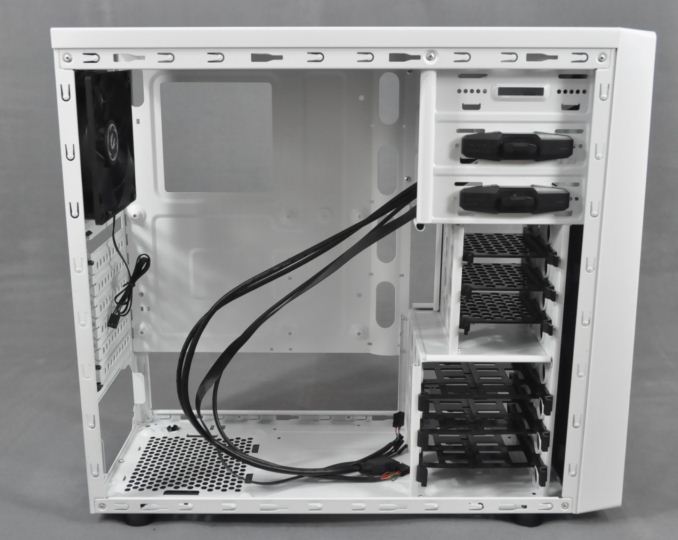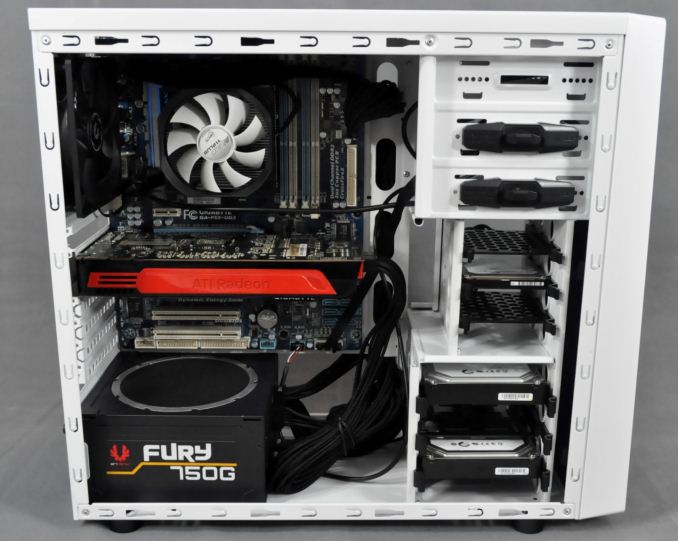BitFenix Neos Case Review
by E. Fylladitakis on January 21, 2015 9:00 AM EST- Posted in
- Cases/Cooling/PSUs
- bitfenix
- Case
BitFenix Neos Interior
The interior of the BitFenix Neos is relatively simple, nearly as much as a generic low cost Mid-Tower case. Everything inside the case is bolted together – no bays or metallic parts are removable. The motherboard tray is sizable enough for a typical ATX motherboard, with an opening behind the CPU area for the installation of CPU coolers.
Of course the size and location won't work for anyone with a motherboard that does not have its CPU socket right at the center of the upper left square area formed by the four screws, which will affect more than half of the motherboards available today, forcing the users to remove them in order to change the CPU cooler. On the other hand, those who rarely change out CPU coolers will be able to install the cooler before installing the motherboard. Note that the case is narrow as well, and CPU coolers taller than 150-155mm are not going to fit. Furthermore, instead of using brass motherboard stand-offs, the tray itself is embossed to form screw fixings for the motherboard. This can make assembly more convenient at times at the cost of some flexibility.
Across the right edge of the motherboard tray, there are four holes for the routing of cables. A fifth hole is present at the top left corner of the tray as well. None of these holes have any rubber grommets and all of them are barely large enough for an ATX 24-pin connector to fit. As there is virtually no clearance behind the motherboard tray for the routing of cables, the right section is elevated for the thick ATX cable to fit. Unfortunately, the use of a couple of PCI Express cables and SATA cables will require more than a little force to close the side panel.
There are three drive cages in the Neos. The top cage is for two 5.25" devices, which can be secured using the plastic locks. The middle cage is narrow, slightly increasing the clearance for one GPU card up to 310mm, and holds three trays for 2.5" devices. Finally, the bottom cage is for three 3.5" devices, but its trays can be used for 2.5" devices as well. For 3.5" devices, no tools are required, but in either case a screwdriver is necessary for the installation of a 2.5" drive.
The motherboard expansion slots are perhaps the greatest issue of the Neos. We have not seen the use of perforated non-reusable covers in a long time, but here they are, the removal of which is permanent and frequently leaves nasty dents behind. Above the expansion slots, the only stock fan of the case can be seen, a black 120mm fan. Take note that due to the narrowness of the case, there is no clearance to install a liquid cooling radiator wider than the fan itself here.
There is plenty of room for any kind of power supply, yet we advise against the installation of a unit longer than 160mm, as the fan opening is small and the displacement of the fan backwards will result in partial blockage, which is a problem with PSUs as it can leave critical components without sufficient cooling. The PSU sits on embossed metallic feet formed from the case panel itself. For this review, BitFenix supplied us one of their Fury 750G PSUs that has individually sleeved cables and is a perfect fit for the Neos.
As exhibited in the pictures of our test build, the interior of the BitFenix Neos is relatively comfortable to work with but can easily end up looking messy, as the cable management options are very limited. The only pathway for the routing of cables, to the right of the motherboard tray, becomes congested with just the thick 24-pin ATX cable going through it. The placement of the hole at the top left corner of the tray appears to have been done with little thought, as a typical motherboard blocks it entirely, leaving no room for a CPU power cable to fit through. There is enough space to comfortably work with the connectors and cables of the 2.5" and 3.5" drives though.
To summarize the component limitations once again, CPU coolers taller than 150mm are not recommended and a single 310mm GPU card may be installed. 160mm long PSUs are strongly advised. The radiators of AIO liquid cooling systems cannot be installed anywhere as well, and the routing options for cables are lacking. Given the price, these flaws could be overlooked provided the performance and other features prove desirable, so let's move on to our testing.


















54 Comments
View All Comments
Gigaplex - Wednesday, January 21, 2015 - link
Their opinion sounds like it is clouded by selecting a Prodigy model with a solid faceplate that blocks airflow. They should have got a mesh faceplate model.Samus - Thursday, January 22, 2015 - link
Yeah, because the mesh faceplate on the model Anandtech just reviewed made such a difference...I really don't think people understand what negative/positive pressure is and how hard it is to properly design an enclosure with zoned cooling.HungryTurkey - Monday, January 26, 2015 - link
Hard? If by Hard, you mean needing an elementary understanding of thermodynamics.... It's a desktop computer people... Not a flipping datacenter with 80,000+ nodes and a staff of 70 generating 40 Megawatts needing 12,000 tons of cooling capacity.Samus - Thursday, January 22, 2015 - link
I'm sorry you are the proud owner of a shitty Bitfenix product, hughlle. Please stop spreading propaganda. To recommend one of these cases to someone is like pushing them off the subway platform...it's something both of you will regret for the rest of your lives. Anyone who lived through the 80's and 90's with the evolution of AT & ATX\BTX will immediately recognize how poorly engineered Bitfenix cases are. It's like buying a Hyundai in the 90's...they'll come around but now is not their time. They're just rebadging Mazda engines and stealing to the best of their ability other manufactures designs. Anything that is actually designed in-house is utter garbage because they clearly don't employ anybody qualified to design cooling enclosures.hughlle - Thursday, January 22, 2015 - link
Firstly, i have been a long time shuttle owner, and for large cases tend to go for silverstone for the aesthetics, currently owning a TJ07 and one of their HTPC cases. I have avoided the prodigy because it was in my opinion, ugly.Secondly. As i mentioned earlier, i'm not too fussed about your opinion which seems driven by resentment, not reality. When the majority of respectable review sites are giving it rave reviews, and 1 nobody is telling me it's like being pushed off a subway platform, i wonder which opinion i'll believe?
You don't like your case, i've no problem with that, but it is readily apparent that your opinion of it is not the accepted opinion of it.
Samus - Thursday, January 22, 2015 - link
Actually the Bitfenix was more of a test than anything. All of my personal cases are Lian-Li or Silverstone, with the FT03 and FT03-mini making up my two primary PC's and the ML03B (a $50 SECC case) making up my HTPC. Although in no way the same style, the ML03B demonstrates a quality SECC design whereas the Bitfenix Prodigy demonstrates everything you shouldn't do with a SECC chassis (heavier/thicker panels, poor quality edges, improper cooling channels and vents and so on.I've used Coolermaster cases with inexpensive builds for friends, such as the Elite 360 ($50) and the SECC quality is there. Bitfenix just doesn't have "it".
I'm a long-time Shuttle user as well, since the Athlon XP days. I've had a K48 Core 2 Duo KPC hosting my Bitcoin miners for years...and before that it was my HTPC. Another quality SECC design. Again, Bitfenix doesn't have it.
hlan - Friday, January 23, 2015 - link
I build systems for over 10 years, and twice systems in Bitfenix Prodigy. Unfortunately, I can confirm the deficiencies mentioned elsewhere, and could add more to the list. A problem I see with case reviews is that they must get published and consequently cannot discover/report problems that occur over time. Sincerely, I wished that Bitfenix gave more attention to quality, it would make their customers loyal and not disgruntled. I appreciate the critical review by anandtech, those reviews elsewhere just singing glory are a waste of time reading.Sushisamurai - Wednesday, January 21, 2015 - link
I think there's an error in the "testing and results" page, when u compare the "neos" with other cases with charts. Both charts are labelled with 850W loads - I think u meant 850W and 450WSushisamurai - Wednesday, January 21, 2015 - link
Oops, never mind, it's CPU and GPU, my eyes are getting too old to read the fine print hahaMurloc - Wednesday, January 21, 2015 - link
I missed that too, I looked at them for a minute and I couldn't find what the temperature was referred to.I went back to look at it now and I finally saw it.